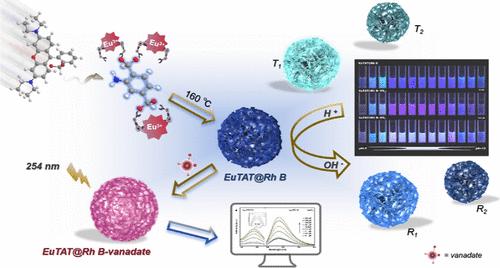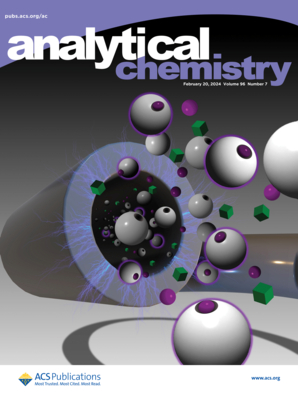Dual-Response Visual Fluorescent Probes for the Determination of Vanadate and Morphology over a Wide pH Range
IF 6.7
1区 化学
Q1 CHEMISTRY, ANALYTICAL
引用次数: 0
Abstract
Vanadate has become an important indicator for environmental testing due to its high toxicity, mobility, and difficulty in degradation. In addition, depending on its dynamic aggregation, analyzing vanadate is not a single content test; it needs further morphological analysis. Previous research has tended to construct a single functional platform with complicated procedures and expensive equipment, making it difficult to obtain a comprehensive picture of vanadate in a short time. Herein, we constructed a dual-response fluorescent probe EuTAT@Rh B formed by Eu3+, 2-aminoterephthalic acid (TAT), and rhodamine B, which could generate structural changes based on the morphology distribution characteristics of vanadate with pH. In the concentration range from 5 × 10–7 to 2 × 10–4 mol/L, the detection limits (3σ/slope, σ = s/I0) of orthovanadate VO43– and metavanadate VO3– were 1.67 × 10–8 and 2.0 × 10–9 mol/L, respectively. In addition, under 254 nm UV light, the spirolactam ring-controlled structures varied with pH and vanadate concentration, producing different types of photochromic structures, which were able to correspond essentially to the pH range of vanadate morphology distribution. Thus, a window with both vanadate and pH signals was constructed under the dual channels of UV and fluorescence, and we successfully achieved the visual integrated analysis of vanadate. This dual-channel visualization method has the advantages of simplifying the analysis process and improving the detection efficiency, which is of great significance in practical applications and provides a way to identify other polymeric substances.

钒酸盐具有毒性高、流动性强、降解困难等特点,已成为环境检测的重要指标。此外,根据其动态聚集性,分析钒酸盐并不是单一的含量检测,还需要进一步的形态分析。以往的研究倾向于构建单一功能平台,程序复杂,设备昂贵,难以在短时间内全面了解钒酸盐的情况。在此,我们构建了一种由 Eu3+、2-氨基对苯二甲酸(TAT)和罗丹明 B 组成的双响应荧光探针 EuTAT@Rh B,它可以根据钒酸盐的形态分布特征随 pH 值的变化产生结构变化。在 5 × 10-7 至 2 × 10-4 mol/L 的浓度范围内,正钒酸盐 VO43- 和偏钒酸盐 VO3- 的检出限(3σ/斜率,σ = s/I0)分别为 1.67 × 10-8 和 2.0 × 10-9 mol/L。此外,在 254 nm 紫外光下,螺内酰胺环控结构随 pH 值和钒酸盐浓度的变化而变化,产生不同类型的光致变色结构,这些结构基本上与钒酸盐形态分布的 pH 值范围相对应。因此,我们在紫外和荧光双通道下构建了一个同时具有钒酸盐和 pH 信号的窗口,成功实现了钒酸盐的可视化综合分析。这种双通道可视化方法具有简化分析过程、提高检测效率等优点,在实际应用中具有重要意义,并为鉴定其他高分子物质提供了一种方法。
本文章由计算机程序翻译,如有差异,请以英文原文为准。
求助全文
约1分钟内获得全文
求助全文
来源期刊

Analytical Chemistry
化学-分析化学
CiteScore
12.10
自引率
12.20%
发文量
1949
审稿时长
1.4 months
期刊介绍:
Analytical Chemistry, a peer-reviewed research journal, focuses on disseminating new and original knowledge across all branches of analytical chemistry. Fundamental articles may explore general principles of chemical measurement science and need not directly address existing or potential analytical methodology. They can be entirely theoretical or report experimental results. Contributions may cover various phases of analytical operations, including sampling, bioanalysis, electrochemistry, mass spectrometry, microscale and nanoscale systems, environmental analysis, separations, spectroscopy, chemical reactions and selectivity, instrumentation, imaging, surface analysis, and data processing. Papers discussing known analytical methods should present a significant, original application of the method, a notable improvement, or results on an important analyte.
 求助内容:
求助内容: 应助结果提醒方式:
应助结果提醒方式:


